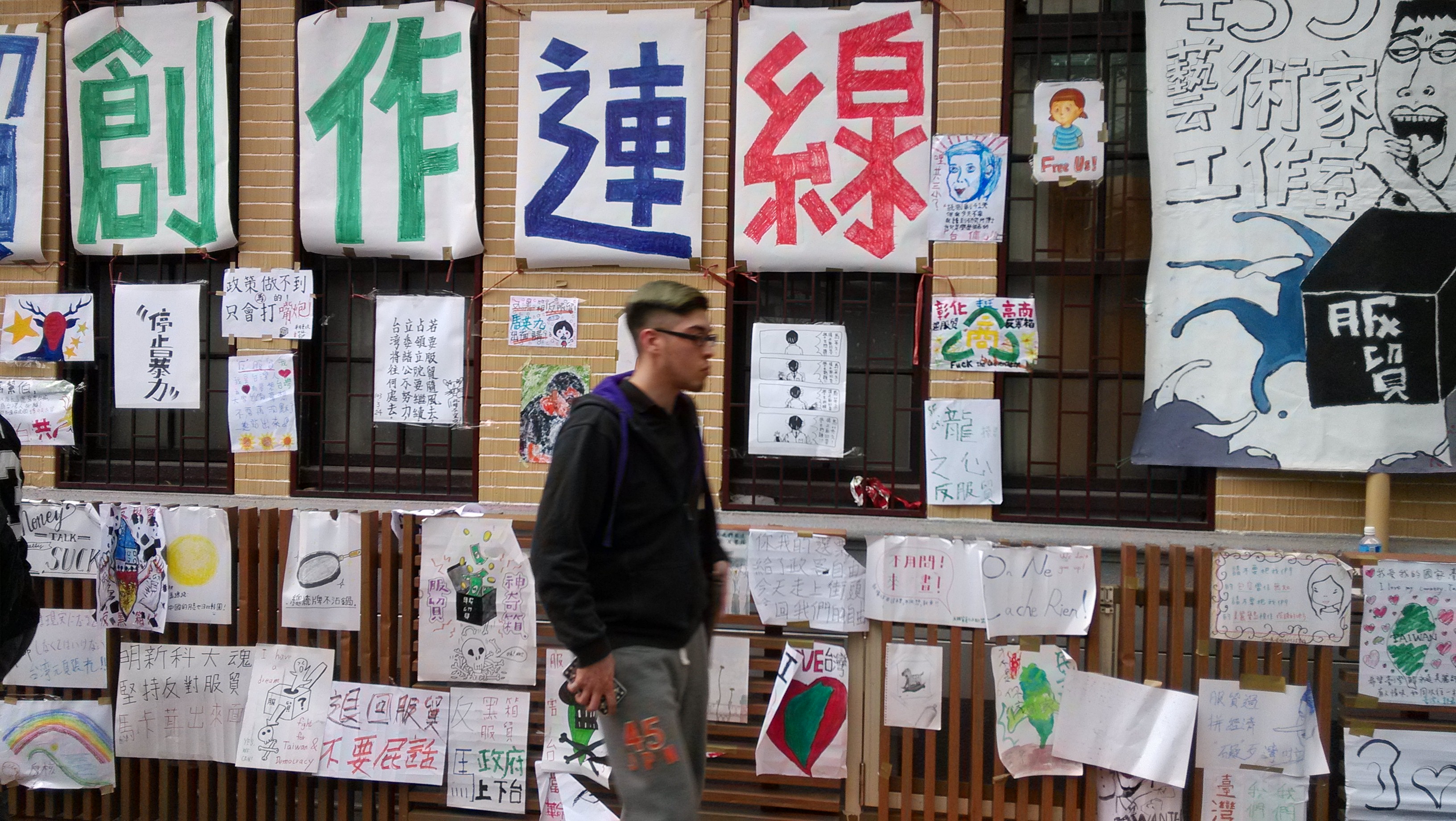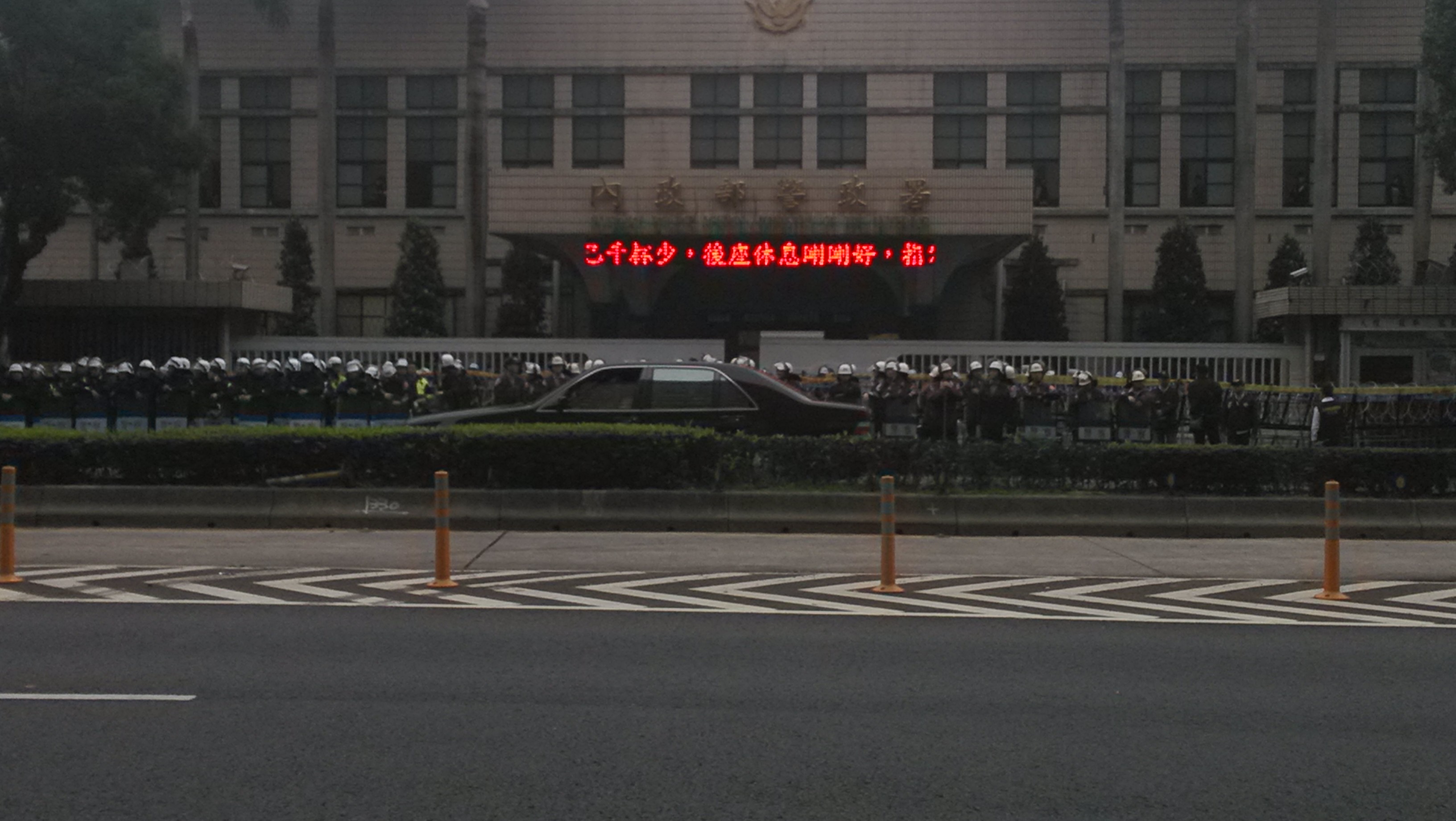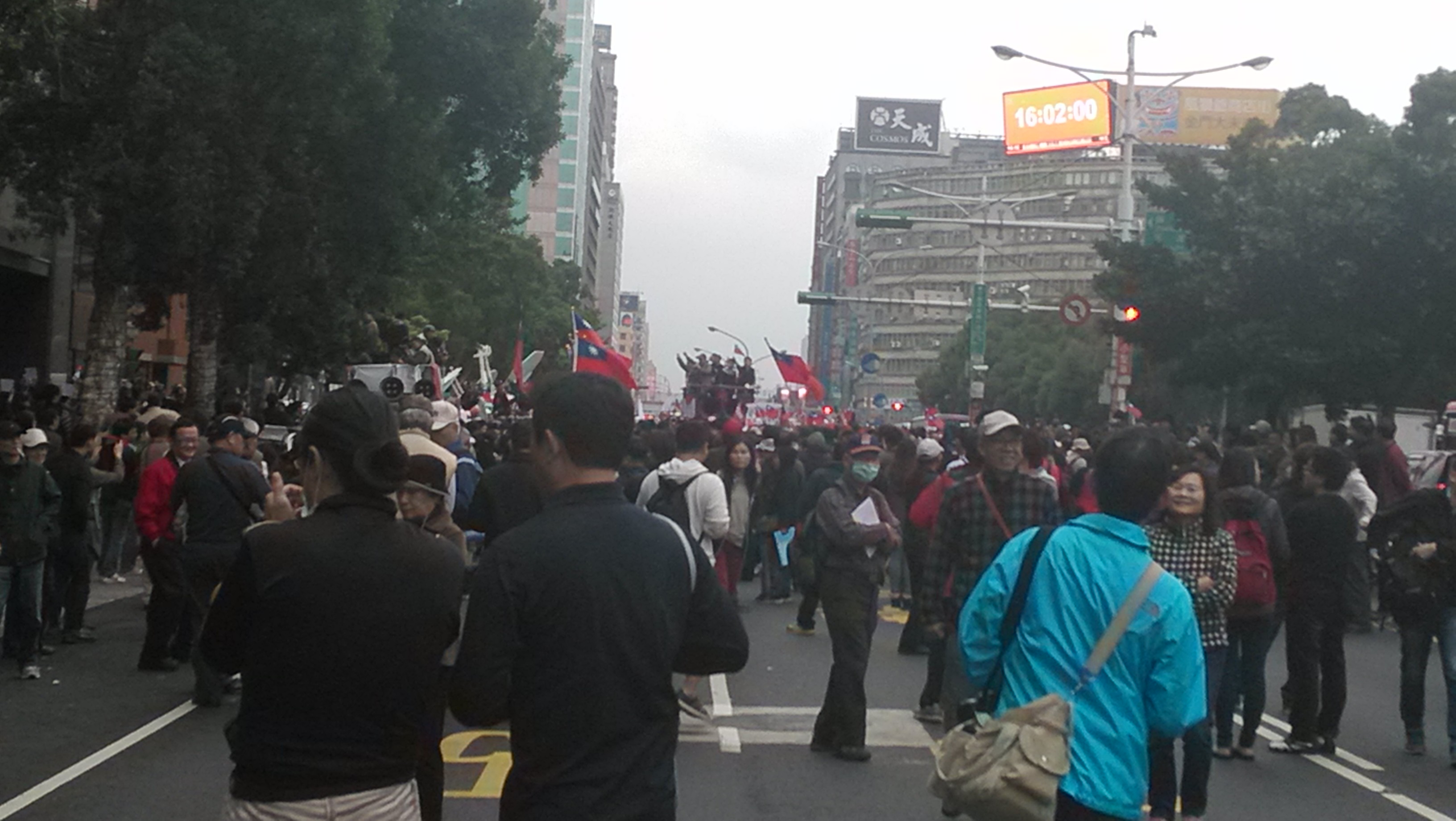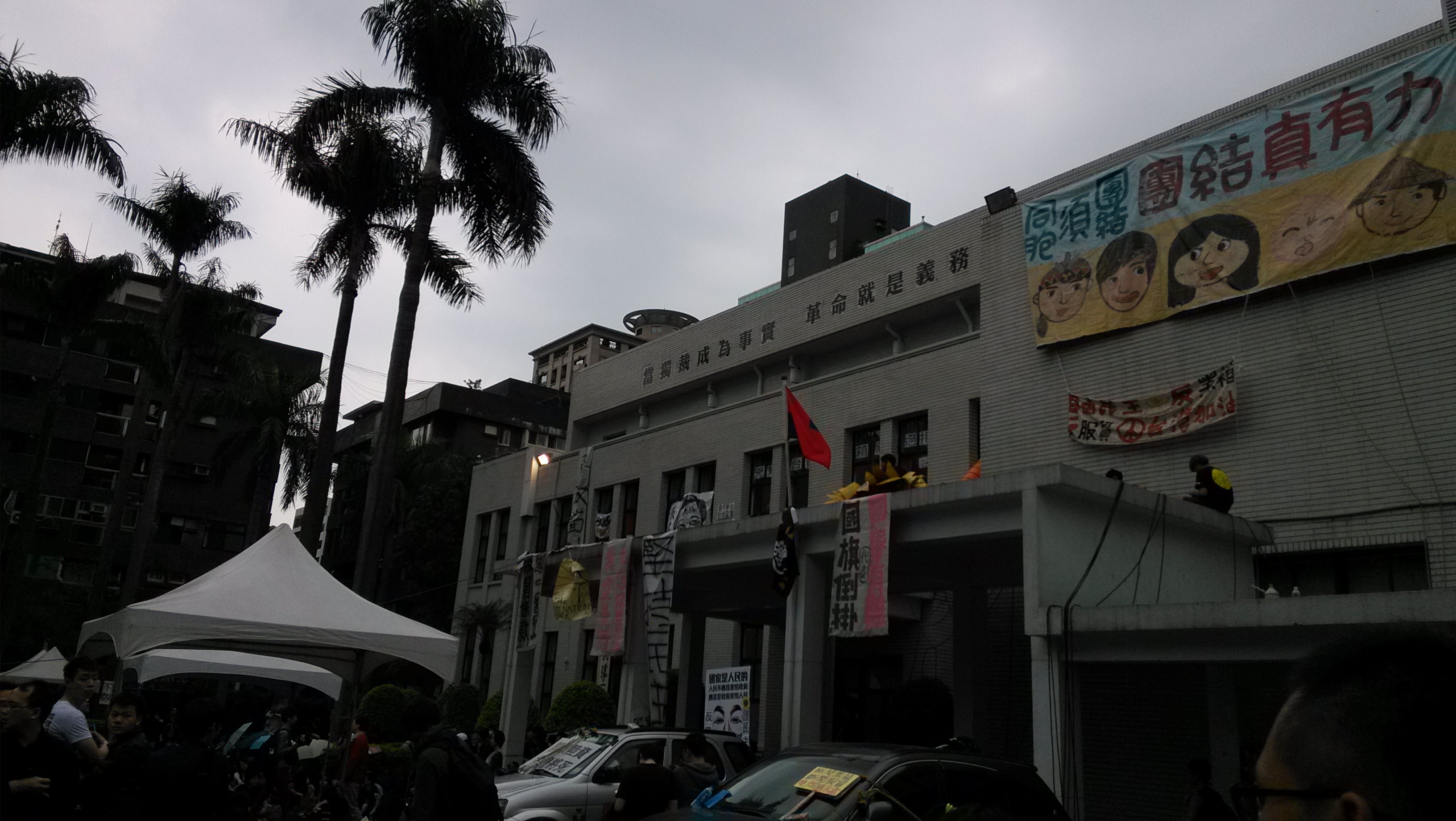A Polemic
by Brian Hioe
語言:
English
Photo Credit: Brian Hioe
FOLLOWING THE SUNFLOWER MOVEMENT, there have been voices have now begun to speak of eliminating the KMT. And it must be wondered what exactly a Taiwanese political spectrum devoid of the KMT would look like. After all, having existed for the entire duration of what we can speak of as “Taiwanese politics,” it is hard to imagine what Taiwanese politics, period, would look like minus the KMT.
Indeed, it is not like that the supporters of the KMT would simply fade away in a political spectrum in which the KMT has ceased to exist. Very probably, current KMT supporters would simply regroup under a new mantle. It may in fact, become more difficult to oppose those who currently compose the KMT subsequent to a rebranding of their political platform.
 Photo credit: Brian Hioe
Photo credit: Brian Hioe
It is also worth asking: Why is it that now has a demand for abolishing the KMT made itself known, though certainly expressed before in the past? The KMT has existed for long enough as a force of oppression in Taiwanese politics; nevertheless, its existence has remained a constant for so many decades despite no small lack of opposition. It was only after the KMT’s recent series of public relations blunders attendant with the Sunflower movement that dismantling the KMT entirely has become a visible political position in some form, though still not exactly a common one. Yet this bespeaks not the potentialities of a changing political atmosphere following the Sunflower movement, but the weaknesses of progressive politics in Taiwan.
It does not appear very likely in the present that the KMT as a whole will become the target of a mass campaign aimed at redressing Taiwan’s democratic woes. Even the Appendectomy Project, whose name in Chinese puns on the notion of removing the KMT from Taiwan as one might remove a cancerous tumor from a diseased body, focused more on targeting especially baneful individual politicians rather than the KMT as a whole. Nevertheless, one might offer some speculations onto the history and future of the KMT, and what the possibility of conducting an assault on the KMT itself would bode.
The Indelible Traces of Authoritarianism
FOR AN OUTSIDE OBSERVER, sometimes it strikes one as remarkable that the KMT has managed to survive this long. The KMT’s apparent incapacity to understand trends in public opinion and its continued hyperbolic attacks upon student protestors, labeling students akin to terrorists, can only appear patently ridiculous and desperate. It is only in the face of a grotesque public conservatism among sections of the Taiwanese public and that for so many years the KMT was the only game in town, that the KMT remains. One speculates the KMT would not actually be able to function as a viable political party capable of running and winning elections through a public relations campaign if not for its long history as the only party existing.
In fact, it is probable that the KMT has never become accustomed to electoral politics. It must be remembered, the KMT is not a “normal” political party operating in a two-party political system. Rather, the KMT is a holdover of the period of one party authoritarian rule that lasted in Taiwan from 1949 to 1996, if one is to accept the presidential victory of a non-KMT party candidate as a metric of Taiwan’s transition from authoritarianism to democracy. Nevertheless, what cheerleaders of Taiwanese democracy have often missed is what should, in fact, strike any serious student of history as quite common sense: even with a supposed “democratic transition,” the authoritarian holdovers of yesterday do not simply fade away. To the extent that the KMT party-state ruled over Taiwan for so many decades, in the fifteen years since, it is not likely that that party-state would have simply dissipated all at once. Traces of it certainly remain.
 Police outside of the Ministry of the Interior. Photo credit: Brian Hioe
Police outside of the Ministry of the Interior. Photo credit: Brian Hioe
And has Taiwan truly achieved a stable two-party democratic system? One in fact wonders. Because while the DPP, which originates in the longstanding effort to form a second political party in Taiwan, did, in fact, win the presidency in 2000 with the victory of Chen Shui-Bian, it did not control the Legislative Yuan at that time and, most significantly, its victory at that time rested upon contingent factors which led to a split vote among KMT voters. There has never been a point at which a non-KMT party has controlled all branches of government.
That commentators viewed the transition to power back to KMT hands following the Chen Shui-Bian presidency as confirmation of the achievement of Taiwanese democracy, that peaceful transfers of power between political parties had become possible in Taiwan, should strike the more aware observer as wishful thinking. In spite of its widespread presence in political mobilization, campaigning, and regional dominance in some areas of Taiwan, the DPP has not achieved the level of de facto political power necessary for it to be deemed a political party capable of vying one-on-one with the KMT. The game remains fixed.
Indeed, while an outsider to the interiority of Taiwanese parliamentary politics can only speculate as to what goes on behind closed doors, it was noticeable that during the Sunflower movement, purported public organs which should be beyond party politics, most prominently the police, generally took the KMT line. KMT influence still pervades within institutional frameworks of government. It is also probable that the financial and economic resources which provided for so many years of KMT dominance are still firmly under KMT control. While one who is not part of the KMT cannot know the inner workings of the KMT, it is a claim circulated within progressive political circles in Taiwan that the KMT may, in fact, be one of the wealthiest political party in the world on account of the vast amount of wealth it siphoned from China in 1947 to 1949 as it fled to Taiwan following defeat to the Chinese Communist Party (CCP) and which remains under KMT control. Indeed, the KMT refused to transfer party assets to the government after democratization. It is, of course, because of Taiwan’s relative lack of international fame, that this aspect of the KMT is almost totally unknown within international discourse.
Shared Origins with the CCP
WE MIGHT, IN FACT devote more attention to the relatively unknown internal nature of the KMT. While another common claim within Taiwanese political vocabulary is that the KMT and CCP are in some form brother parties, the strife between the KMT and CCP being something like sibling rivalry, one must remember, political rhetoric aside, the KMT and CCP do in fact share an origin within the gestational matrix of Republican era China.
Within the English language scholarship about the KMT, it is popular to bash the “Leninist party” structure of the KMT. Indeed, in the 1920s, with the then-world shaking Russian Revolution in 1917, putative nationalist parties across the world sought to emulate the structure of the Bolsheviks in order to appropriate the Russian Revolution as a model for what their national self-strengthening projects which usually involved the formation of a nationalist political party that advocated national revolution. Given Sun Yat-Sen’s admiration for Vladimir Lenin as a “revolutionary saint,” and idealization of the Russian Revolution, the early KMT reorganized as a Bolsheviks mimic.
 Pro-unification politician and former gangster “White Wolf” Chang An-lo and supporters. Photo credit: Brian Hioe
Pro-unification politician and former gangster “White Wolf” Chang An-lo and supporters. Photo credit: Brian Hioe
It is questionable to which extent the KMT retains its Leninist party structure. Indeed, when the KMT is referred to as a “Leninist party,” usually it is as an attack upon the KMT’s authoritarian aspects; such arguments usually do not touch upon the specific genealogy of the KMT which can be traced to the Bolsheviks’ internal party organization if at all, but rather employs the term merely as reference to general forms of authoritarianism, belying lazy historical scholarship and the legacy of Cold War anti-communism more than anything else.
Nevertheless, one can draw very direct parallels with the Chinese Communist Party which, of course, at one point in history operated very closely with the KMT, and which also developed its internal structure in mimicry of the Russian Bolsheviks.
Taiwan and China’s Democratic Question
IN PAST WEEKS, commentators upon Taiwanese politics have sought to tortuously link Taiwan’s own struggle for democracy with China’s Tiananmen Square Massacre, which recently saw its 25th anniversary. The quandary faced by such commentators is how to maintain the connection between Taiwan and China’s struggles for democracy while still maintaining the separability of Taiwan and China with regard to Taiwanese pro-independence claims. In acceptance of the separability of a “Taiwanese” and a “Chinese” cultural identity, for Taiwanese, Tiananmen Square should be for Taiwanese an incident which happened in a country with no relation to their own.
Attempts at linking Tiananmen to Taiwan which try to connect the struggle for Taiwanese democracy to supposed Chinese struggles for democracy have therefore struggled with maintaining the separability of Taiwan and China while insisting nonetheless upon connection on this issue. What such attempts have theretofore neglected is the way in which Taiwanese and Chinese national identity might be understood as not tied to Taiwan or China as defined in terms of each country’s specific territorial geography but in terms of the inheritances of cultural identity. That is, the identity of Taiwan as one of several countries composed of largely ethnically Chinese individuals and with strong influence from Chinese culture but not under the sovereignty of China itself. In this way, China might be said to be at once the closest and farthest country from Taiwan.
As such, with the rise of the Sunflower movement in recent months, some have sought to draw connection between the Sunflower student movement and Tiananmen Square. Perhaps, in the long view schema of history. Of course, this does in fact miss the point that Taiwanese and Chinese political history is quite simply separate after 1895 in the arena of pure historical fact, apart entirely from the strivings of pro-independence and pro-unification politics over interpretations of Taiwanese history. Indeed, there is no point in that 119 year history since 1895 in which the same government which controlled mainland China also controlled Taiwan at the same time. The Sunflower movement was not inspired by Tiananmen Square, it was a product of domestic and international issues purely pertaining to Taiwan that happened to occur close to the recent anniversary of Tiananmen Square.
Certainly, Tiananmen Square was quite directly an inspiration for the Wild Lily movement in 1990 which was instrumental behind Taiwan’s shift from authoritarian one-party rule to something resembling two-party democracy, yet also was concerned with purely Taiwanese issues.
Nevertheless, here we might return to the KMT and CCP in regards to the long-term historical relation between both parties and their structurally conditioned responses to popular protest which is a product of this history.
Lingering Structures of the Party-State
IN VIEW OF THE KMT’s rhetoric on the Sunflower movement, in comparison to the rhetoric of the CCP during the Tiananmen Square incident, one is struck by the similarities of phrasing. Within the CCP, students were viewed as working quite deliberately against China’s national interest. Accordingly, it was believed that there was no way that students could have organized so effectively on their own—it could only, then, be a product of outside interlopers operating behind and manipulating students. Here one finds direct parallels to the KMT’s claims that students were working against Taiwan and merely being manipulated by the DPP to the CCP.
It appears that there is a trait—perhaps essence—common to the CCP and KMT found in their historical origins: that is, their framework for considering the world remains the perspective of peering out from the party-state apparatus at society beyond itself. Such captures the deficiency of both party apparatuses at understanding society at large beyond itself. In the case of Tiananmen Square, the CCP overreacted and badly mismanaged what might not have had to be a PR disaster internationally, which remains forever a scar on its legitimacy globally—though not in China itself. Namely, whatever the view of western commentators who have never taken the time to internally examine events, the Tiananmen Square protestors were themselves internally disorganized and their worldview not so diametrically opposed to the CCP that the CCP could not have resolved the situation without the use of force. Similarly, though purely a matter internal to Taiwan, cannot we point to the means by which the KMT’s own grotesque PR failures served merely to accentuate the crisis that the Sunflower movement expressed. As indicated by the movement’s own internal contradictions and the internal contradictions present in Taiwanese activist politics, it is not impossible that had the KMT had a more coherent way of evaluating events, it could have nipped the movement in the bud.
Taiwan scholars grasping the shared structural basis of the CCP and KMT have therefore studied Taiwan’s democratic transition for the sake of speculating as to what a future democratic transition on the part of the CCP would look like. Wishful thinking. Likely, the CCP is not going to go away soon, no matter the up and downs of China’s economy and regardless of occasional ethnic strife in outer regions of China and fantastical visions of China suddenly splintering regionally apropos of nothing. And to concern one’s self with Taiwan merely for the sake of larger concerns with China once more reproduces the existential quandary of Taiwan, once more, as in this case of speculating as to what a future China would look like through Taiwanese history.
But with the growing alignment in recent years of the CCP and KMT despite some decades of past conflict, it proves of necessity to examine both parties in relation to each other. Indeed, why has it that, for example, the KMT now favors pro-China policies when during the decades of the Martial Law period, it was bent on the reconquest of China through military means for many years even as the actuality of this became more and more unlikely as time went on?
Strange Bedfellows: A Product of “Double Consciousness”?
SOME HAVE POSED, the apparent alliance between the CCP and the KMT as the “United Front” of both, in which the vested interests of both the CCP and KMT came to share the belief that Taiwanese democracy was against the interests of both groups and so came to ally accordingly.
While, again, with states and parties, one can only truly speculate from the outside if one is not a high-ranking member of one party or another, such a view strikes the present author as a tad too conspiratorial. One cannot know the inner workings of either the KMT or the CCP, but one would think that both genuinely think in terms of what they view as the national interest, rather than in terms of maintaining their own power, or being opposed to democracy. Political parties, even authoritarian ones, are not usually so cabalistic in their self-understanding, and while some speculate as to KMT politicians having been bought off by the CCP, if not impossible, such views sometimes verge on the conspiratorial.
One must take at face value that KMT politicians may view their actions, however seemingly in favor of China and not Taiwan, however apparently acting in their own self-interest, as being for the benefit of the “Taiwanese” people. Though corruption is certainly rampant, how else to explain the apparent tortuousness of that the current generation of KMT politicians, including current president Ma Ying-Jeou, were actually born, raised, and have their entire families in Taiwan, but nonetheless have historically acted against the development of Taiwanese democracy and against Taiwanese national interests? Indeed, behind the closed doors of the KMT, it really not impossible that the KMT does have some secret agreement with the CCP. If not at the party level, there are almost certainly individual members of the KMT that do, in fact, have secret dealings with China. One wonders how many. Yet it cannot be all.
If this does not suffice to explain the conflicted actions of some members of KMT leadership in regards to China, the party leadership being hardly a homogeneous entity in itself, certainly it does explain the mindset of the KMT rank and file that do not make decisions for the party, but are the necessary constituency which have allowed for the persistence of the party up until to the present—however some commentators would like to depict the KMT as a purely elite institution cut off from the people entirely backed by a oligarchical minority, non-elite KMT supporters certainly do exist. It is they who are almost certainly caught in the binds of a “double consciousness” between Taiwan and China and whose political affiliation is determined accordingly. And if one is to dismantle the KMT, this base of support must be eroded away at.
Taiwan Minus the KMT?
TO JUMP BACK to a long view of history, one might turn one’s attention to the broader condition of modernity in Taiwan and China as rooted in its historical roots. With the inability of the KMT to reconquer China and the turn of the CCP towards some merger of state central power and free market capitalism following the Deng era, both the KMT and the CCP are entities which have become disconnected entirely from their historical raisons d’être. Accordingly, now both parties grope around in the darkness for new purpose to maintain their continued existence and the existence of the structures that were shaped and developed underneath them. It is such that CCP and KMT alliance has been conducted on the basis of that now reunification policies have become of tantamount importance.
For the KMT, now that reconquest of China is an impossibility and with its subsequent loss of that raison d’être, the priority has become unification—a priority which trumps internal domestic Taiwanese issues. For the CCP, it has become a priority not to quash Taiwanese democracy in itself, but to resolve what it views as internal issues for future stable growth outwards, and this view now finds itself coinciding with the KMT’s as both parties now find themselves in a crisis of purpose. And, in fact, it is very probable that the KMT and CCP were not so far apart during the decades of purported warfare between Taiwan and China; for it is now known that Chiang Kai-Shek was always at least in communication with Mao through his Zhejianese fellow, Zhou Enlai. Even at that point in history sometimes Taiwanese and Chinese interests vis-a-vis other foreign actors coincided and demanded coordination or at least communication. Very probably similar ties remain between both political parties, maybe not at the party level, but certainly through influential individuals.
Lastly, one need only reimagine Taiwan without the KMT to understand how critical the KMT-CCP connect is to cross-strait rapprochement.
Speculatively, dismantling the KMT would lead to a blow against the historical party-state apparatus which persisted from the martial law period. If there are, in fact, conspiratorial elements underlying the KMT, dismantling it will at least drag these out further into the light. After a break-up of the KMT, it would be more difficult for such elements to regroup, much less conduct negotiations on a one-one-one basis with China which, likely, would not acknowledge other party governments of Taiwan in light of its historical relationship with the KMT. The center-right and right elements behind the KMT will probably regroup in new form, but this would at least provide for some breathing space, and a shift in terrain in the Taiwanese political spectrum.
 Legislative Yuan under occupation. Note the upside-down Taiwanese flag: the Taiwanese flag contains the KMT party emblem within it, so it is popularly associated with the KMT. Photo credit: Brian Hioe
Legislative Yuan under occupation. Note the upside-down Taiwanese flag: the Taiwanese flag contains the KMT party emblem within it, so it is popularly associated with the KMT. Photo credit: Brian Hioe
However, more significantly, a Taiwanese political spectrum minus the KMT would lead to a complete shift in cross-strait relationships with China. No more would the CCP be able to conduct relations with the KMT, which it at least knows and is acquainted with. And, indeed, so too with the U.S., whose presence is always somewhere in the background of cross-strait affairs, and which can depend on the KMT to maintain a more familiar regional order in a way that the DPP poses a wild card. This is evidenced in actions of American officials to discredit Tsai Ing-wen dating back several years.
Perhaps we might even go so far as to say that the gamble of targeting the KMT be to shake up the regional situation of Taiwan, China, and potential for conflict of East Asia at large. But, in this, more must be deliberated of the limits, possibility, and prospects of the present moment, of which there has been too little consideration. Let us seek to radically alter the course of discussion, then, in the hopes of being able to radically alter the course of future events as they come.

